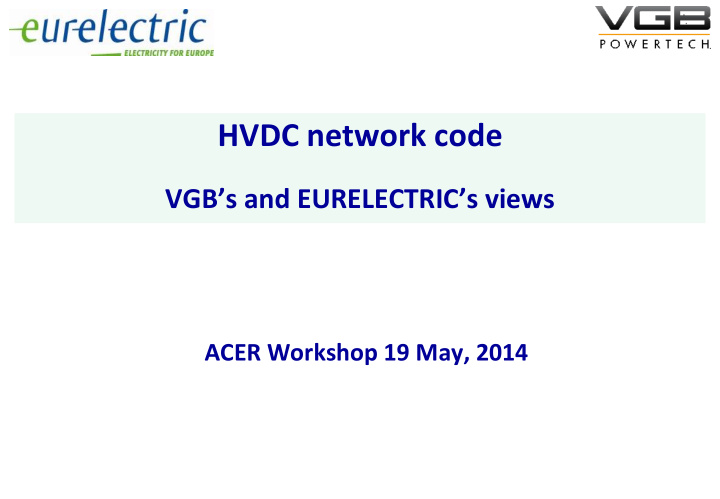



HVDC network code VGB’s and EURELECTRIC’s views ACER Workshop 19 May, 2014
Process to prepare the HVDC code Draft HVDC code: “It incorporates the input of an extensive informal and formal dialogue with stakeholders , including meetings, public workshops, a “Call for Stakeholder Input” between 7 May 2013 and 7 June 2013, a formal consultation in accordance with the provisions of the Article 10 of Regulation (EC) N ° 714/2009 during November and December 2013 aiming at exchanging views on the challenges and key issues.” In our view about 80% of comments are not incorporated. How do the other stakeholders see this?
Process to prepare the HVDC code The process to prepare the code so far not satisfactory: • Significant mistakes in the draft code led to ambiguities and misinterpretations, several stakeholders* criticized this in ENTSO-E workshop 4 December • Public consultation must be based on documents of good quality to ensure proper stakeholder consultation that supports the preparation of the code • Stakeholders had only a limited time to investigate the new version of the code dated 30 April, published on 2 May, prior to today’s workshop 19 May ACER should ensure thorough analysis of the code and adequate dialogue with stakeholders *) see e.g. VGB Presentation ENTSO-E Workshop 04 December 2013
Significance of HVDC systems Art. 16.1.d allows each TSO to impose its own thresholds for voltages • Low voltages should be excluded to avoid application to convertor stations used in domestic photovoltaic installations and small industrial applications. • Isn’t the aim to apply the network codes to significant grid users? Threshold for the capacity or for the voltage should be included
Coherence with other Network Codes The European Commission plans to include a stakeholder committee in the final version of RfG NC and the CACM NC. Stakeholder involvement is crucial for sound implementation of the network codes. Stakeholder committee should be included also in this NC.
Connection of offshore wind farms According to Regulation 2009/714 Article 8.6.b ENTSO-E has to develop NCs describing the characteristics at the connection point (the interface between grid user and transmission/distribution grid). This principle is not respected in this NC HVDC for offshore PPMs connected via a privately owned HVDC link
Competition distortion In Art.3.5 : HVDC systems owned by TSO do not have to fulfil the same requirements as systems owned by private grid users The same rules should apply to all parties, and there should be no discrimination leading to competition distortions. In cases where a TSO is owner or operator, the relevant NRA can supervise the duties of the TSO for this kind of HVDC systems.
Coherence with other Network Codes Art. 7.1 imposes frequency ranges wider than those indicated in the NC RfG and NC DCC. • This means a lack of coherence between codes leading to additional investments without added value. • Operation in the extended range (without generators and demand) only possible for voltage controlled converters (operation for current controlled converters is physically impossible) – It will result in high additional costs for active filtering – It will exclude the robust current controlled converters The content should be coherent with other codes
Conclusions The Code should: • be in line with the requirements of the framework guidelines • be coherent with other Network Codes • ensure cost efficient solutions • avoid discrimination • Include no unclarities or mistakes
Back up slides
Connection of offshore wind farms • According to EC 2009/714 Article 8.6.b, ENTSO-E has to develop NCs describing the characteristics at the connection point (the interface between grid user and transmission/distribution grid). This basic principle is not respected in the NC HVDC. • If one single legal entity wants to install an offshore wind farm connected to the onshore grid via its own (privately owned and operated) HVDC link, this code imposes also the characteristics at the offshore convertor station. The offshore convertor station is an element inside the private installation of the grid user. ENTSO-E has only the right to impose requirements at the onshore connection point. • If the HVDC link is owned/operated by a TSO or independent third party, creating an off shore grid with unusual frequency and/or voltage, this code should stipulate that the NC RfG is not applicable. Harmonisation at European level for such configurations should be implemented.
Recommend
More recommend